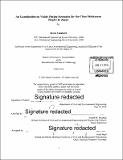| dc.contributor.advisor | Joseph M. Sussman. | en_US |
| dc.contributor.author | Yasutomi, Ryota | en_US |
| dc.contributor.other | Massachusetts Institute of Technology. Department of Civil and Environmental Engineering. | en_US |
| dc.coverage.spatial | a-ja--- | en_US |
| dc.date.accessioned | 2016-09-13T19:25:23Z | |
| dc.date.available | 2016-09-13T19:25:23Z | |
| dc.date.copyright | 2016 | en_US |
| dc.date.issued | 2016 | en_US |
| dc.identifier.uri | http://hdl.handle.net/1721.1/104322 | |
| dc.description | Thesis: S.M. in Transportation, Massachusetts Institute of Technology, Department of Civil and Environmental Engineering, 2016. | en_US |
| dc.description | Cataloged from PDF version of thesis. | en_US |
| dc.description | Includes bibliographical references (pages 174-182). | en_US |
| dc.description.abstract | The Chuo Shinkansen Maglev project is the world's first application of the Superconducting Maglev for High-Speed Rail (HSR), which will provide a dramatic travel time saving for the main artery of Japan, the Tokyo-Nagoya-Osaka corridor. While the project is expected to bring a large economic and social benefit, it is required to be long-term/two-phase project, with 18-year long interval between the commencement of Tokyo-Nagoya in 2027 and that of Nagoya-Osaka in 2045, since the project has to be financed solely by a private company, Central Japan Railway Company (JR Central). In order to shrink the total project period and the long interval between two phases, the improvement in the financial viability of JR Central after the Tokyo-Nagoya operation is critical. The thesis examines viable pricing strategies of the Chuo Shinkansen Maglev, in terms of the determination of the fare level as well as the application of dynamic pricing, taking into account some unique specifications of the Chuo Shinkansen Maglev. First, the thesis proposes a framework to support the fare level determination of the Chuo Shinkansen Maglev. As a cost side approach, the upper-limit fare constrained by the full-cost principle regulation in Japan is discussed. As a demand side approach, the willingness to pay for the travel time saving of the Chuo Shinkansen Maglev, in comparison to the Tokaido Shinkansen, is analyzed. Based on the framework, the thesis suggests the appropriate scope of the fare level and proposes the implementation plans for the fare structure of the Chuo Shinkansen Maglev. Second, this thesis proposes the application of dynamic pricing for the Chou Shinkansen Maglev, as a tool to increase the profitability of the project. The dynamic pricing behavior of TGV Paris- Lyon and Acela Express in Boston-New York-Washington DC are benchmarked from the customers' perspective. Based on the observed pricing behavior of each operator, as well as the specifications and market situation of the Chuo Shinkansen Maglev, the thesis recommends the customer-friendly pricing strategy, which can soften the negative impression of the price gouging, would be suitable in order to achieve the successful implementation of the dynamic pricing for the Chuo Shinkansen Maglev. | en_US |
| dc.description.statementofresponsibility | by Ryota Yasutomi. | en_US |
| dc.format.extent | 182 pages | en_US |
| dc.language.iso | eng | en_US |
| dc.publisher | Massachusetts Institute of Technology | en_US |
| dc.rights | M.I.T. theses are protected by copyright. They may be viewed from this source for any purpose, but reproduction or distribution in any format is prohibited without written permission. See provided URL for inquiries about permission. | en_US |
| dc.rights.uri | http://dspace.mit.edu/handle/1721.1/7582 | en_US |
| dc.subject | Civil and Environmental Engineering. | en_US |
| dc.title | An examination on viable pricing strategies for the Chuo Shinkansen Maglev in Japan | en_US |
| dc.type | Thesis | en_US |
| dc.description.degree | S.M. in Transportation | en_US |
| dc.contributor.department | Massachusetts Institute of Technology. Department of Civil and Environmental Engineering | |
| dc.identifier.oclc | 958279486 | en_US |
